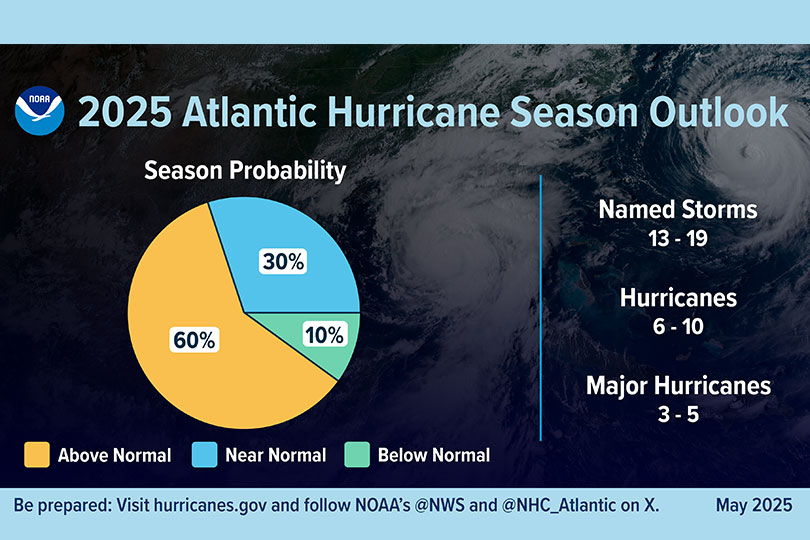By Emmy Powell
Communications Specialist
The National Oceanic and Atmospheric Administration (NOAA) is forecasting an above-normal 2025 hurricane season, citing favorable conditions for increased tropical storm development.
Weather experts estimate there is a 60% chance of an above-normal season, a 30% chance of a near-normal season and only a 10% chance of below-normal activity. NOAA has 70% confidence in these predictions.
“NOAA and the National Weather Service are using the most advanced weather models and cutting-edge hurricane tracking systems to provide Americans with real-time storm forecasts and warnings,” U.S. Secretary of Commerce Howard Lutnick said. “With these models and forecasting tools, we have never been more prepared for hurricane season.”
Continued ENSO-neutral conditions, warmer-than-average ocean temperatures, weak wind shear and increased activity from the West African Monsoon contribute to the above-normal season forecast this year. These elements together create conditions for tropical storm formation.
Elevated ocean heat content and reduced trade winds further enhance storm development and intensity. A potential northward shift in the West African Monsoon could generate tropical waves that often lead to stronger, longer-lasting storms.
“As we witnessed last year with significant inland flooding from hurricanes Helene and Debby, the impacts of hurricanes can reach far beyond coastal communities,” said Acting NOAA Administrator Laura Grimm. “NOAA is critical for the delivery of early and accurate forecasts and warnings, and provides the scientific expertise needed to save lives and property.”
For those living along the Gulf Coast and down along the Rio Grande Valley, it’s important to be prepared.
“This outlook is a call to action: be prepared. Take proactive steps now to make a plan and gather supplies to ensure you’re ready before a storm threatens,” NOAA’s National Weather Service Director Ken Graham said..
NOAA’s outlook forecasts 13 to 19 named storms. Of those, six to 10 could become hurricanes, which have sustained wind speeds at a maximum of at least 74 mph.
Forecasters anticipate three to five major hurricanes, which are considered Category 3 status with winds of at least 111 mph.
NOAA’s outlook is for overall seasonal activity and is not a landfall forecast.
Hurricane season, which starts June 1, ends Nov. 30, but hurricanes can make landfall outside of the typical season.
For more information on hurricane season, visit www.weather.gov.


Leave A Comment